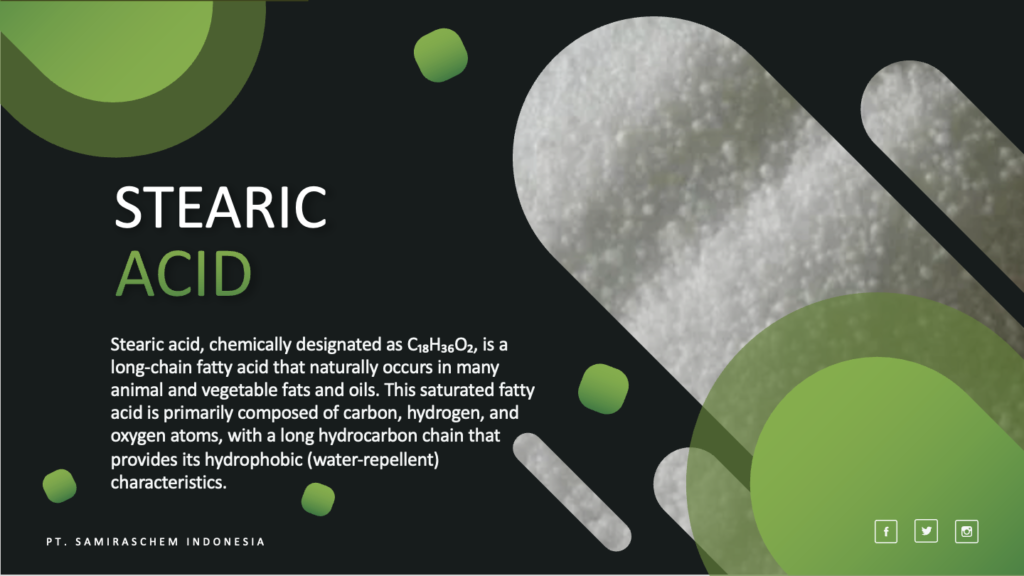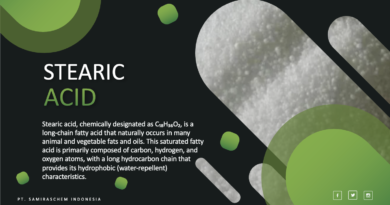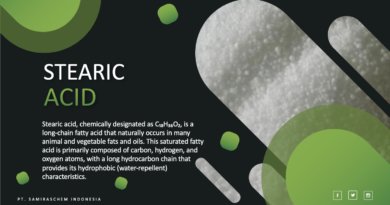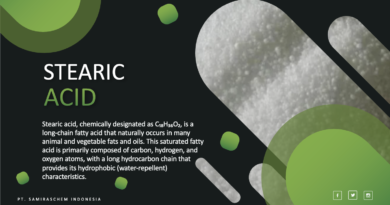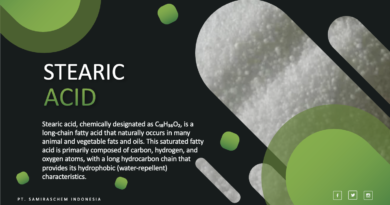Stearic Acid
Stearic acid, chemically designated as C₁₈H₃₆O₂, is a long-chain fatty acid that naturally occurs in many animal and vegetable fats and oils. This saturated fatty acid is primarily composed of carbon, hydrogen, and oxygen atoms, with a long hydrocarbon chain that provides its hydrophobic (water-repellent) characteristics. It is one of the most common fatty acids in nature, alongside palmitic acid, and has a wide range of uses in various industries due to its versatile properties.
Stearic acid Chemical Properties
Stearic acid has a molecular formula of C₁₈H₃₆O₂, with a molar mass of about 284.48 g/mol. It consists of 18 carbon atoms in a straight-chain configuration, making it a long-chain saturated fatty acid. It is solid at room temperature, with a melting point between 69°C and 72°C, and is insoluble in water but soluble in organic solvents like alcohol, ether, and chloroform. Octadecanoic acid is typically found in a white, crystalline, waxy solid form and has a mild odor.
belongs to a class of chemicals known as carboxylic acids due to its carboxyl group (-COOH) attached to the end of the carbon chain. This carboxyl group is responsible for its acid behavior, though it is relatively weak in its acidity compared to inorganic acids. The long carbon chain makes it hydrophobic, which imparts water-repelling properties useful in many industrial applications.
Natural Sources
found in a variety of animal and vegetable fats, with its concentration varying widely depending on the source:
- Animal Fats: Beef tallow and lard are rich sources of stearic acid. Animal fats generally have higher concentrations of saturated fatty acids, making them a significant source of stearic acid.
- Vegetable Oils: Some vegetable oils, like cocoa butter, shea butter, and palm oil, contain substantial amounts of stearic acid. In cocoa butter, for instance, can make up around 30–35% of the total fat content.
- Synthetic Production: Industrially, can also be synthesized from oleic acid through a process called hydrogenation, where unsaturated fatty acids are converted into saturated forms by the addition of hydrogen.
Industrial Applications
Stearic acid is highly valued across various industries, thanks to its stabilizing, emulsifying, thickening, and lubricating properties. Some of its most notable applications are listed below:
1. Cosmetics and Personal Care Products
-
- Emulsifier: widely used in skincare and cosmetic products as an emulsifying agent. It helps bind water and oil together, creating a smooth, stable product. It’s found in lotions, creams, and moisturizers.
- Surfactant: In personal care formulations, acts as a surfactant, which helps to cleanse the skin by attracting dirt and oil.
- Thickener: Due to its waxy texture, it serves as a thickening agent in creams and lotions, enhancing the texture and feel of the products.
- Hair Care: In shampoos and conditioners, it helps to form a protective layer on the hair strand, adding shine and preventing moisture loss.
2. Pharmaceuticals
-
- Tablet Manufacturing: commonly used as a lubricant and binder in tablet manufacturing. It prevents tablets from sticking to the machinery during production and helps them maintain their shape.
- Suppositories: Due to its melting properties, stearic acid is ideal for use in suppositories, allowing them to dissolve at body temperature.
3. Food Industry
-
- Food Additive: Although not very common, stearic acid is sometimes used in the food industry as an anti-caking agent, emulsifier, or thickener. It is classified as generally recognized as safe (GRAS) by the U.S. Food and Drug Administration (FDA).
- Candy Production: It can be used in the manufacturing of certain candies to prevent ingredients from sticking to each other.
4. Rubber and Plastics Industry
-
- Vulcanization Process: In the rubber industry, stearic acid is used in the vulcanization process, where it helps sulfur bond with rubber to improve its elasticity and durability. This is especially crucial in tire manufacturing.
- Plasticizer and Stabilizer: Stearic acid acts as a plasticizer, making plastics more flexible. It also serves as a heat stabilizer in plastic products, enhancing their thermal stability during processing.
5. Metallurgy
-
- Stearic acid is used as a lubricant in metalworking processes, such as die casting and pressing. It helps prevent metals from sticking to machinery, reducing friction and wear on equipment.
- It also finds use as a mold-release agent in casting applications, where it allows for easier removal of cast metals or plastics from their molds.
6. Candles and Soap Making
-
- Soap Making: Stearic acid is a popular ingredient in the soap industry. When combined with sodium hydroxide, it forms a solid soap with good cleaning properties. It also contributes to the hardness and durability of soaps.
- Candles: In candle production, stearic acid is used to harden paraffin wax and raise the melting point of candles, resulting in longer-lasting, drip-resistant candles.
7. Lubricants and Greases
-
- Stearic acid’s hydrophobic properties make it an excellent choice for water-resistant lubricants and greases. It is commonly used in lubricating greases for automotive and industrial machinery.
Environmental and Health Considerations
Stearic acid is considered safe and environmentally friendly in most applications. However, there are some considerations:
- Environmental Impact: As a naturally occurring substance, itself does not pose significant environmental risks. However, the sourcing of stearic acid, especially from palm oil, has raised concerns over deforestation, biodiversity loss, and greenhouse gas emissions. Sustainable sourcing of palm oil is encouraged to mitigate these issues.
- Health and Safety: considered safe for use in food, cosmetics, and pharmaceuticals by regulatory agencies worldwide. In high concentrations, it may cause mild skin irritation, but such effects are rare and mild.
Stearic acid Benefits and Challenges
Benefits
- Biodegradability: readily biodegradable, making it environmentally friendly.
- Versatility: Its chemical structure allows it to function as an emulsifier, thickener, stabilizer, and lubricant across various industries.
- Sustainability: Derived from both animal and plant sources, it is relatively sustainable, especially when sourced from renewable resources.
Challenges
- Supply Chain Issues: The production of stearic acid from palm oil has led to deforestation and environmental degradation in tropical regions. There is a growing demand for sustainably sourced stearic acid.
- Allergic Reactions: Though rare, some people may experience mild allergic reactions to stearic acid in cosmetics or personal care products.
Future of Stearic Acid
As industries seek more sustainable and environmentally friendly alternatives, the future of stearic acid lies in sustainable sourcing practices and innovative applications. The move toward sustainably sourced palm oil and increased production of stearic acid from alternative sources, such as algae and other bio-based feedstocks, is becoming a priority for manufacturers. Additionally, as consumer preferences shift toward natural and biodegradable products, the demand for stearic acid is likely to grow, especially in the cosmetic and personal care sectors.
Research is also exploring the potential of stearic acid in biodegradable plastics and eco-friendly lubricants, which may open new applications and markets. Moreover, advancements in green chemistry are likely to lead to more efficient and sustainable production processes for stearic acid, reducing its environmental footprint and increasing its appeal as an eco-friendly ingredient.
PT. Samiraschem Indonesia is Reliable Supplier and Distributor Stearic acid with High Quality Product and Good Price.
Stearic acid is a versatile and valuable fatty acid with widespread applications across multiple industries. Its emulsifying, thickening, and lubricating properties make it a staple ingredient in cosmetics, pharmaceuticals, food, rubber, plastics, and metalworking industries. Although it has faced scrutiny regarding environmental concerns, especially related to palm oil production, sustainable sourcing practices are being adopted to mitigate these impacts. As the demand for natural, biodegradable, and eco-friendly materials continues to rise, stearic acid is likely to remain a prominent ingredient in various industries, with new applications emerging as technology advances.
